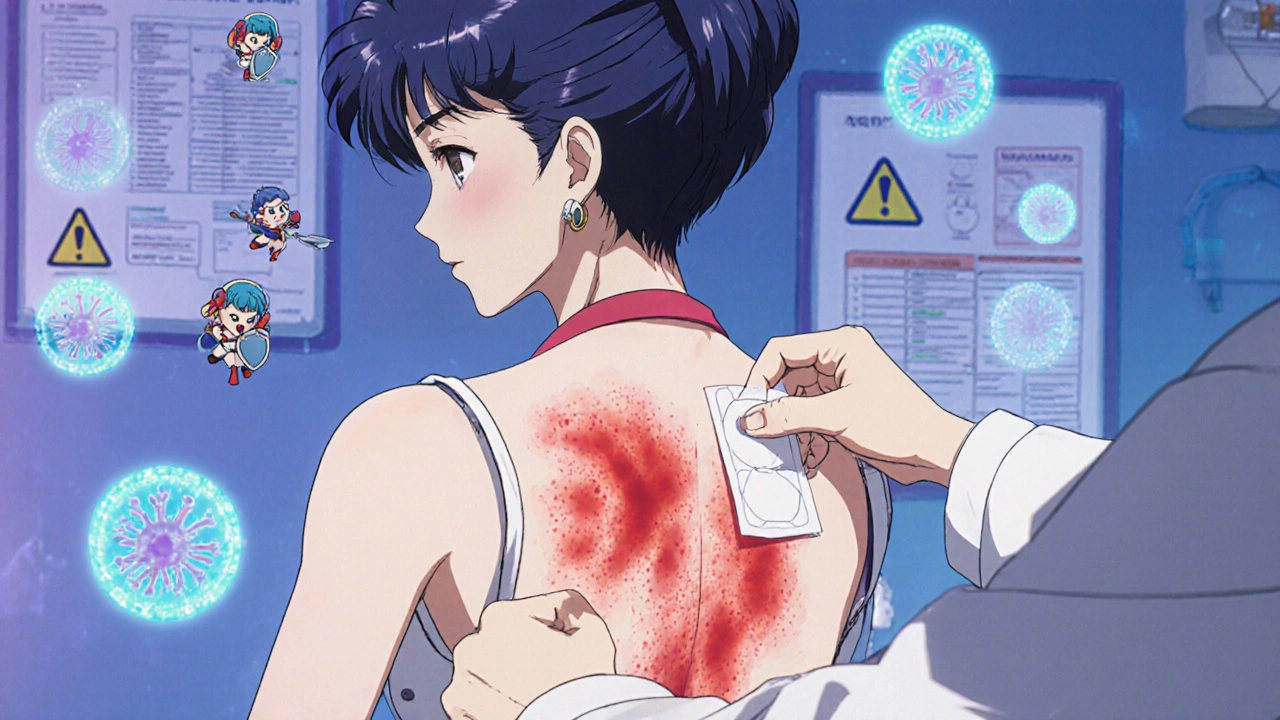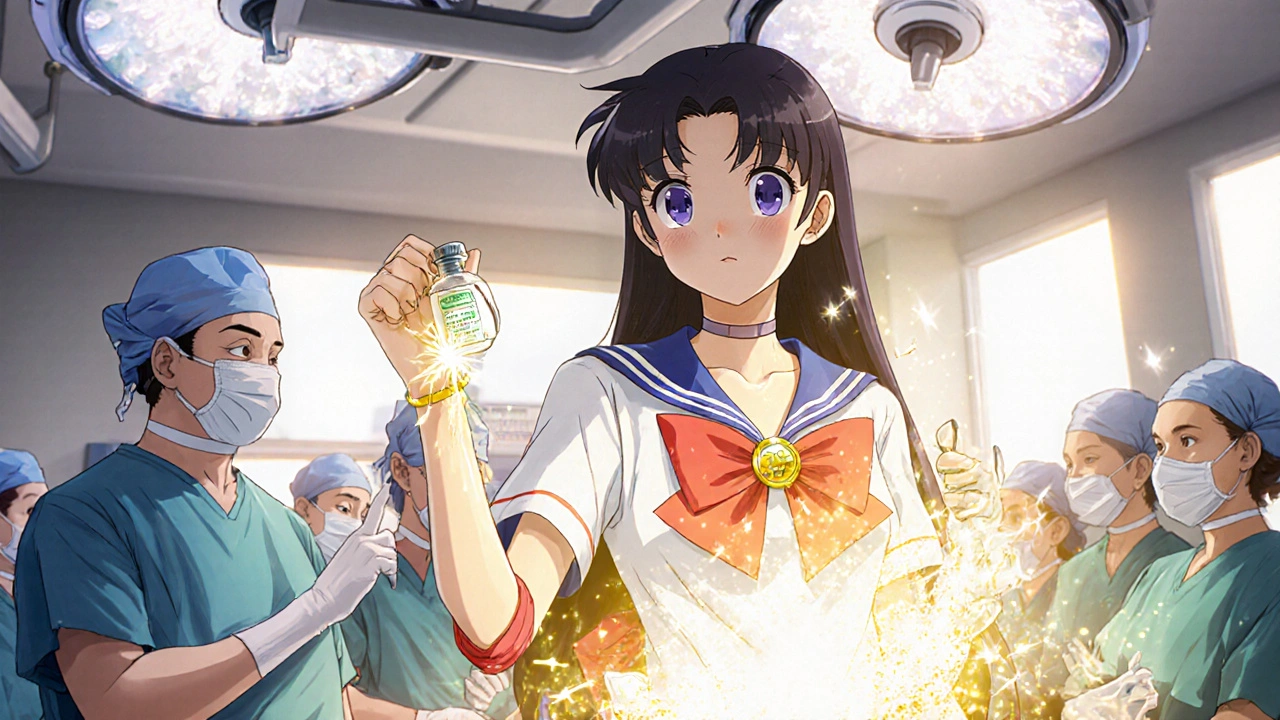Povidone-Iodine Allergy: Symptoms, Diagnosis, and How to Manage It
 Oct, 30 2025
Oct, 30 2025
Most people think of povidone-iodine as a safe, go-to antiseptic for cuts, scrapes, and surgical prep. You’ve probably seen it in first aid kits, hospitals, or pharmacies-brown liquid, sharp smell, stings a little but gets the job done. But what if your skin doesn’t just sting? What if it swells, burns, or breaks out in angry red bumps days after use? You might not realize it, but you could be having an allergic reaction to povidone-iodine.
What Is Povidone-Iodine, Really?
Povidone-iodine is a complex made of iodine bound to a polymer called povidone. It slowly releases iodine, which kills bacteria, viruses, and fungi on contact. That’s why it’s used before injections, during surgery, and on wounds. It’s cheaper and less irritating than alcohol for many people, which is why it’s everywhere.
But it’s not pure iodine. That’s a key point. People often confuse povidone-iodine with elemental iodine, which is toxic if ingested. The body doesn’t react to the iodine in povidone-iodine the same way it reacts to seafood iodine or contrast dyes. Still, some people develop allergies to the povidone-iodine complex itself, not just the iodine component.
What Does a Povidone-Iodine Allergy Look Like?
Symptoms don’t always show up right away. You might use it on a cut on Tuesday and not notice anything until Thursday. That delay makes it easy to miss the connection.
- Red, itchy rash around the application site-often raised, blistered, or scaly
- Swelling of the skin, lips, or eyelids after use
- Burning or stinging that lasts longer than a few minutes
- Hives that spread beyond where the product was applied
- Difficulty breathing or tightness in the throat (rare, but serious)
In rare cases, anaphylaxis can happen. That’s life-threatening. If you feel your throat closing, your chest tightening, or your tongue swelling after using povidone-iodine, call emergency services immediately. Don’t wait.
Some people mistake contact dermatitis for an allergy. Contact dermatitis is a delayed irritation, not an immune response. But with true allergy, your body releases histamine and other chemicals, causing systemic symptoms. The difference matters for treatment.
Who’s at Risk?
Not everyone gets this reaction. But certain groups are more likely:
- People with a history of atopic dermatitis or eczema
- Those with known iodine sensitivity (though this is often misunderstood)
- Patients who’ve had multiple surgeries or frequent wound care
- Healthcare workers exposed to povidone-iodine daily
- People allergic to other topical antiseptics like chlorhexidine
Here’s a hard truth: many doctors still assume iodine allergy means you can’t have shellfish. That’s outdated. Shellfish allergies are to proteins in the meat, not iodine. But because of this myth, people are wrongly told to avoid povidone-iodine when they don’t need to. Conversely, some people with real allergies are misdiagnosed and kept using it-until something bad happens.
How Is It Diagnosed?
There’s no blood test for povidone-iodine allergy. Skin testing is the gold standard.
A patch test is usually done first. A small amount of povidone-iodine is placed on your back under a patch and left for 48 hours. Then the doctor checks for redness, swelling, or blistering. A positive result means your immune system reacted.
If the patch test is negative but symptoms are still suspicious, a prick test or intradermal test might be done. These are more sensitive but carry a small risk of triggering a reaction. They’re only done in controlled medical settings.
Some clinics use a graded challenge-applying tiny amounts of povidone-iodine over several days while monitoring for symptoms. This is risky and should only be done under supervision.
Don’t try to test yourself at home. If you’ve had a reaction before, assume you’re allergic and avoid it until you see an allergist.

What Should You Do If You’re Allergic?
First, stop using povidone-iodine. Immediately. Even if the reaction seems mild, re-exposure can make it worse.
Wash the area gently with water and mild soap. Apply a cool compress if it’s swollen or itchy. Over-the-counter hydrocortisone cream can help with mild rashes. Antihistamines like cetirizine or loratadine can reduce itching and hives.
For moderate to severe reactions, you’ll need a prescription. Oral steroids like prednisone are often used for a short course to calm the immune response. In cases of anaphylaxis, epinephrine is the only life-saving treatment.
Once you’ve had a confirmed reaction, you need a medical alert bracelet or card. List it as “Allergic to Povidone-Iodine (Betadine).” Tell every doctor, nurse, dentist, and pharmacist you see. Even if they don’t ask, say it. Many don’t realize this allergy exists.
What Can You Use Instead?
You don’t have to go without antiseptics. There are safe alternatives:
- Chlorhexidine gluconate (Hibiclens)-often used in hospitals. But if you’re allergic to chlorhexidine too, skip this.
- Alcohol-based solutions (70% isopropyl alcohol)-good for skin prep before injections. Doesn’t work as well on dirty wounds.
- Hydrogen peroxide-not recommended for open wounds anymore. It damages tissue and slows healing.
- Hexachlorophene-used in some surgical scrubs. Less common now.
- Silver-based dressings (like silver sulfadiazine)-great for burns and chronic wounds.
For everyday cuts, plain saline rinse and a clean bandage often work better than any antiseptic. The body heals best when it’s not fighting chemicals.
What About Dental or Surgical Use?
Povidone-iodine is sometimes used in mouth rinses before dental work or as a surgical scrub. If you’re allergic, this could be dangerous.
Always inform your dentist or surgeon ahead of time. Ask them to use a non-iodine alternative. For example, chlorhexidine mouthwash is common in dentistry and safe for most people with povidone-iodine allergy.
Surgeons may use chlorhexidine-alcohol solutions for skin prep instead. Make sure your surgical team knows your allergy before they prep you. A simple mistake can lead to a severe reaction during surgery.

Can You Outgrow It?
Unlike food allergies, povidone-iodine allergies rarely go away on their own. Once your immune system has reacted to it, it remembers. Re-exposure-even years later-can trigger the same or worse symptoms.
Some people think they’re “no longer allergic” because they used it again without a reaction. But that’s likely because the dose was too low, or the reaction was delayed and missed. Don’t test it.
There’s no proven way to desensitize someone to povidone-iodine. Unlike penicillin, where gradual exposure can build tolerance, iodine allergies are unpredictable and risky to try to override.
When to See a Specialist
If you’ve had any reaction-even mild-after using povidone-iodine, see an allergist. Not your GP. Not your pharmacist. An allergist.
They’ll confirm the diagnosis with proper testing, help you understand what you’re allergic to, and give you a written action plan. They can also test you for other allergies you might not know about, like chlorhexidine or preservatives in topical products.
Keep a record: write down when you used it, what symptoms appeared, how long they lasted, and how they were treated. Bring that to your appointment. It helps.
Final Thoughts
Povidone-iodine is useful. But it’s not harmless. For most people, it’s fine. For a small but real number, it’s dangerous. If you’ve ever had a strange skin reaction after using it, don’t brush it off. Don’t assume it was just a burn or irritation.
Take it seriously. Get tested. Tell your care team. Carry your allergy information. Your next cut, injection, or surgery could depend on it.

Marcia Facundo
November 1, 2025 AT 11:28Used Betadine on a cut last year and broke out in hives two days later. Thought it was laundry detergent. Turns out, it wasn't. Learned the hard way.
Now I carry a card in my wallet. Don't be like me.
Joseph Kiser
November 3, 2025 AT 01:48This is the kind of post that saves lives. Seriously.
So many people get told 'it's just irritation' when it's a full-blown immune response.
Stop normalizing delayed allergic reactions. They're not 'bad luck'-they're a warning sign.
If you've ever had a rash after surgery or a shot and shrugged it off-you're playing Russian roulette with your body.
I've seen people get anaphylaxis because they didn't know. Don't be one of them.
Get tested. Tell your doctors. Write it on your phone lock screen if you have to.
This isn't medical jargon. This is survival.
And if you're a healthcare worker? Stop assuming everyone knows this. Educate. Always.
👏
Roy Scorer
November 4, 2025 AT 00:43Oh here we go again with the 'allergy' narrative.
People don't understand chemistry. It's not an 'allergy'-it's chemical irritation masquerading as immunology.
You think your skin is 'reacting'? It's just oxidizing. The iodine is corrosive, not magical.
And why do we treat this like some rare disease? It's a topical antiseptic, not a vaccine.
Stop medicalizing every minor skin reaction. You're creating hypochondriacs.
Use soap and water. It's cheaper, safer, and doesn't require a PhD to understand.
And if you're allergic to iodine? Then don't eat seaweed either. Consistency matters.
Also, chlorhexidine is just as toxic if misused. Why are we demonizing one and glorifying another?
This is fearmongering dressed as education.
Wake up.
It's iodine. It's not a demon. It's an element.
And you're not special because your skin tingles.
Hazel Wolstenholme
November 4, 2025 AT 23:26How delightfully quaint that we’ve elevated a humble topical antiseptic to the pantheon of 'life-threatening allergens.'
One must wonder whether this proliferation of 'povidone-iodine awareness' is a product of modern hypersensitivity-or merely a symptom of our collective pathological need to pathologize the mundane.
Indeed, the very notion that a compound used since the 1950s in every operating room from Omaha to Osaka could suddenly be deemed 'dangerous' speaks volumes about our contemporary epistemological crisis.
Let us not forget: the human body evolved alongside iodine-rich marine environments; to fear it now is to reject evolution itself.
And yet, here we are, scribbling medical alert bracelets like medieval pilgrims carrying relics of the saints.
Chlorhexidine? Hydrogen peroxide? Please. These are not 'alternatives'-they are chemical compromises.
The real solution? Let the body heal. Let nature abhor a vacuum. Let the skin breathe.
Or, if you must, use a sterile gauze and a prayer.
And for heaven’s sake, stop prescribing antihistamines for what is, in 97% of cases, mere dermatological pique.
Ajay Kumar
November 4, 2025 AT 23:37Wait wait wait-so you’re saying if I’m allergic to Betadine, I might not be allergic to shellfish? That’s wild.
I’ve been avoiding shrimp since I got a rash from a wound cleaning in 2015.
My mom told me iodine = seafood = same thing.
Now you’re telling me that’s a myth?
So all these years I’ve been scared of lobster because of a cut on my knee?
That’s like being scared of rain because you got wet once.
And why is everyone so obsessed with patch tests?
Why not just stop using it if it burns?
Also, in India, we use turmeric paste. Works better. No hospital needed.
And no one’s got a medical alert bracelet for turmeric.
Maybe we’re overcomplicating this.
Also, why do Americans need so many labels for everything?
It’s just a brown liquid.
Not a cult.
Not a religion.
Just soap with iodine.
Stop making it a superhero villain.
Mike Laska
November 5, 2025 AT 06:13I had a reaction once. Just a little redness. Thought nothing of it.
Then I got surgery. They used Betadine again. I woke up with my face swollen like a balloon.
They didn’t even ask. Just slapped it on.
That’s not negligence. That’s criminal.
I’m not exaggerating. I couldn’t open my eyes for three days.
They gave me steroids. I cried for a week.
Now I carry a laminated card in my wallet.
And I scream it at every nurse who walks in.
‘BETADINE IS MY ENEMY.’
They look at me like I’m crazy.
But I’m the one who lived.
Don’t let this happen to you.
Don’t be polite.
Be loud.
Be annoying.
Be the guy who ruins the procedure because you’re alive.
It’s worth it.
Alexa Apeli
November 5, 2025 AT 21:15Thank you for sharing this vital information with such clarity and compassion. 🌸
It is truly heartening to see a post that not only educates but empowers individuals to advocate for their own health.
Every person deserves to be heard, especially when it comes to medical safety.
May we all be as courageous as those who speak up-and as diligent as those who listen.
Wishing you and all readers continued healing and peace of mind. 💛
With gratitude,
Alexa
Eileen Choudhury
November 6, 2025 AT 00:05I’m from India and we use neem and turmeric for everything-cuts, burns, even acne.
But I’ve seen nurses here use Betadine like it’s water.
My cousin got a rash after a dental cleaning. No one believed her until she broke out in blisters.
Now she carries a note in Hindi and English.
And guess what? The hospital changed their protocol.
One voice. One story. One small act of courage.
You don’t need a lab to prove your body’s telling you something.
Listen to your skin.
Speak up.
And if someone says ‘it’s just a reaction,’ tell them: ‘No, it’s my body saying NO.’
We’re not broken. We’re just not listened to.
Thank you for writing this.
It matters.
Zachary Sargent
November 6, 2025 AT 18:42So let me get this straight-some guy in a lab decided that a brown liquid that stings is now a death sentence?
And now we’re all supposed to carry ID cards because we got a rash?
Next thing you know, we’ll need a permit to use soap.
Also, why is everyone acting like this is new?
I’ve been using Betadine since I was 5.
No allergies.
My dog licks it off my knee.
He’s fine.
So maybe the problem isn’t the iodine.
Maybe it’s the people.
Just stop being dramatic.
It’s not a cult.
It’s not a conspiracy.
It’s a damn antiseptic.
Grow up.
Melissa Kummer
November 6, 2025 AT 22:57As a registered nurse with over 12 years of clinical experience, I cannot stress enough the importance of this information.
While povidone-iodine is widely regarded as benign, its potential for delayed-type hypersensitivity reactions is grossly underrecognized in primary care settings.
I have personally witnessed three cases of anaphylactoid responses post-surgical prep, all of which were initially misattributed to anesthesia or latex.
Documentation of patient-reported reactions must be standardized across electronic health records.
Additionally, preoperative screening protocols must evolve beyond the outdated iodine-shellfish myth.
Thank you for elevating this critical patient safety issue.
Continuing education is not optional-it is ethical.
andrea navio quiros
November 8, 2025 AT 16:27allergy is a word people throw around too much
skin gets red sometimes
it happens
not everything is immune system drama
my cousin used betadine for a burn and it turned red
he cried
we put aloe on it
next day fine
no bracelet needed
no doctor
no test
just water and time
stop making everything a crisis
your skin is not a bomb
it just wants to heal
and you’re overthinking it
you’re not special
it’s just a liquid
stop
Pradeep Kumar
November 10, 2025 AT 11:30Bro, I work in a rural clinic in Bihar.
Every day, people come with cuts from farming, bike accidents, kitchen burns.
We use Betadine because it’s cheap, works, and we don’t have alternatives.
But last month, a girl got a rash after we used it.
Her mom said she’d had it before.
We stopped. Used saline and honey.
She healed in 3 days.
Now we ask: ‘Ever had a rash after this?’
Simple.
No forms.
No bracelets.
No drama.
Just listen.
And if you’re scared, ask.
Don’t assume.
Don’t be loud.
Just be kind.
And maybe, just maybe, that’s the real medicine.
Andy Ruff
November 11, 2025 AT 02:01Let me be perfectly clear: if you’re allergic to povidone-iodine, you’re a liability.
Not because you’re weak-because you’re irresponsible.
You didn’t get tested until after you had a reaction?
That’s not an allergy. That’s negligence.
You didn’t tell your surgeon?
That’s not a medical error. That’s criminal incompetence.
And now you want everyone to carry a card?
Why? So you can be the center of attention every time you walk into a clinic?
Stop turning your personal failure into a public mandate.
There are millions of people who use this stuff daily without issue.
And now you want to make them all jump through hoops because you didn’t do your homework?
Get tested before you use it.
Don’t wait until your face swells.
Then complain.
Then demand a movement.
That’s not advocacy.
That’s narcissism dressed in a medical alert bracelet.
Grow up.
Joseph Kiser
November 12, 2025 AT 19:07Wow. So now the person who survived anaphylaxis is ‘a liability’?
And the nurse who saw three cases is ‘incompetent’?
And the girl in India who healed with honey is ‘dramatic’?
Let me ask you this: if your child had a reaction and you didn’t know why, would you want someone to tell you to ‘grow up’?
Or would you want someone to say: ‘Here’s how to stay alive’?
You call it narcissism.
I call it survival.
And I’d rather have 10,000 people carrying cards than one person die because someone thought it was ‘just a rash.’
So go ahead.
Call me dramatic.
Call me emotional.
Call me a hypochondriac.
But when your next doctor reaches for Betadine, I hope you’re loud enough to stop them.
Because I won’t be.
And neither will the next person who dies quietly in an OR because no one asked.